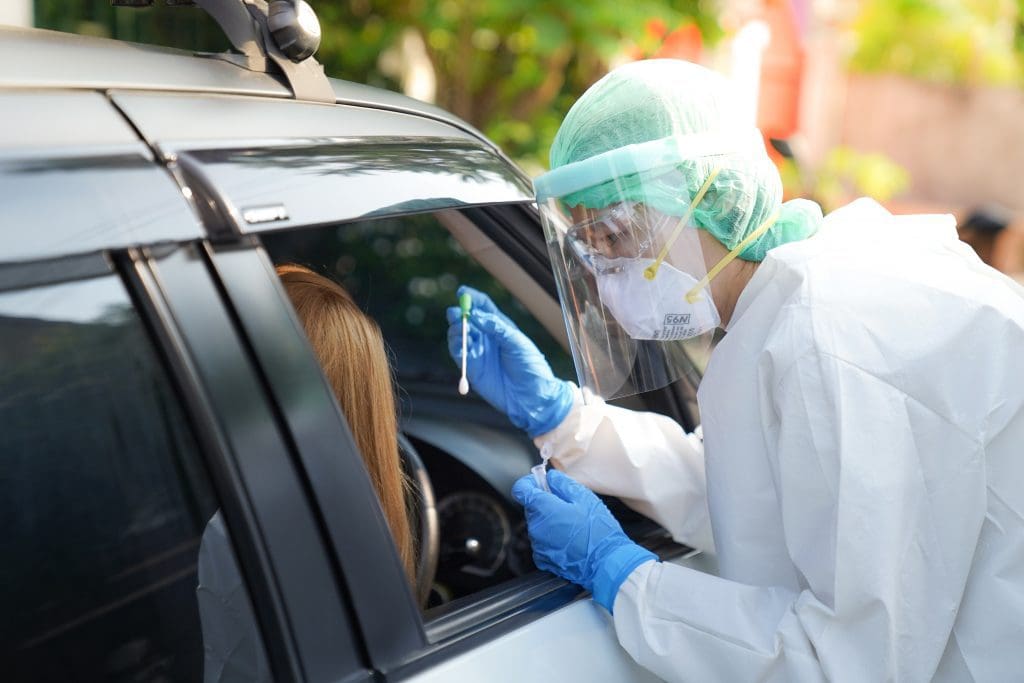During this unprecedented time in history, nurses are taking on new roles and responsibilities. One role that nurses in outpatient settings are taking on is working at specimen point of collection (SPOC) sites. These sites provide testing for COVID-19 in a safe manner that minimizes contact between the person administering the test and the person under investigation (PUI). SPOC sites are primarily drive-through with PUIs remaining in their vehicle while the nurse or other healthcare worker provides the test. Little literature exists to help guide SPOC site managers and organizers as they endeavor to set up SPOC sites. I hope the information I provide in this article can serve as a preliminary guide to help event organizers as they arrange SPOC testing in their communities. To have the most effective SPOC, four main principles must guide organizers—patient confidentiality, patient safety, staff safety, and efficiency.
Patient confidentiality
Keeping patient confidentiality not only meets HIPAA requirements, but also assists with the overall efficacy of the SPOC site. The history of epidemics and plagues is riddled with examples of confidentiality being breached and chaos ensuing for the individuals involved. There are some aspects of pandemic responses that push greater ethical questions about confidentiality, especially in the realm of contact tracing and disease investigation. But with the SPOC site, the more care the staff takes in maintaining confidentiality, the more likely patients are to seek out testing. In studies about HIV treatment uptake, keeping confidentiality has been the best method of increasing engagement with treatment. The same situation can be extrapolated to a serious infectious disease like COVID-19. Patient confidentiality must be preserved to the greatest extent possible.
There are many practical ways in which this principle can be addressed while planning for an SPOC site. Moving the testing site itself away from major roads embraces this principle, even if the site is simply hidden behind a building or the next street over. In addition, organizers can have signs posted at the site prohibiting video recording and pictures. Enforcement of this policy is essential. Organizers also can be sure to provide patients with a written copy of their rights under HIPAA so that patients are aware of their right to confidentiality and are more likely to engage with public health efforts for testing, tracking, and treatment.
Patient safety
Medical errors are one of the leading causes of death in the United States. For this reason, a culture of patient safety must be preserved, even in times of national emergency. As with any sort of medical procedure, it’s important for the nurse to verify the patient by at least two identifiers before testing. This will ensure that the right patient is getting tested and that public health can perform the correct follow-up in case of a positive test. Also, since the majority of the SPOC testing sites are being conducted in an outdoor setting with the use of private vehicles, vehicles should be placed in park before performing testing such as nasopharyngeal swabbing or throat culture on the driver of a vehicle. This reduces the risk of an adverse event occurring.
Staff safety
To provide safe patient care, staff must be able to work within an environment that also promotes their safety. Providing adequate personal protective equipment (PPE) for the environment and the infectious pathogen that is being tested for is the best way to provide a safe environment. However, as it was seen in March and April of 2020, PPE is not always available when there is an increased demand for it. Staff education about the infectious agent is always important, but it’s particularly key when PPE resources are low or not available so that staff can make informed decisions. Education about the pathogen also helps staff understand the best way to provide care while wearing PPE.
In addition to education, engaging staff through use of shared governance and giving staff the forum to raise concerns and have questions answered will greatly ease the stress and anxiety that accompanies working at an SPOC site.
The use of PPE also presents many challenges, especially if SPOC is being conducted in an outdoor setting. With extremes of hot and cold, organizers need to be aware of OSHA guidelines in regard to working in these situations and provide mitigation. For example, OSHA stresses the importance of rotating staff and providing recovery periods, in addition to providing fluids at a specified temperature and using different mitigation strategies based on the heat index. Heat, specifically, is a well-researched, recognized workplace hazard and providing mitigation not only protects staff, but also ensures that the SPOC is operating consistently when the temperatures become elevated. Organizers also need to have inclement weather policies in place and plan for adverse weather.
Nurses should try to use nonrestrictive methods to complete testing on pediatric patients as a first option. Due to the risk of transmission, caregivers should help with pediatric PUIs. In addition, nurses must be permitted to decline to test an uncooperative PUI who is unable to be adequately restrained or therapeutically held. Uncooperative patients present a risk to staff safety because of the possibility of a tear in the PPE and exposure to the pathogen. Using additional staff and keeping smaller children in car seats may help make testing safer.
It’s also essential that public safety be present at the SPOC sites for two reasons—traffic flow and the fact that high stress situations can often lead to unpredictable behavior. Public safety can either take the form of hired security or the local police department. If planning for a large testing event, coordinating with local police will be essential if lines spill out onto major streets. The presence of public safety may also be enough to mitigate any risk of negative behavior that could compromise the safety of the SPOC site.
Efficiency
For the SPOC site to be effective, it must be efficient. The goal of the site is to engage the community with public health. If the testing experience takes too long or is cumbersome, patients aren’t going to be as likely to return and the disease could potentially continue to spread in the community. Fortunately, principles such as Lean Six Sigma can guide organizers in improving efficiency. Efficiency considerations include:
Adequate staffing. Organizers should be realistic about the number of staff required.
Test kits. Some test kits require that the nurses swish the swabs for 10 seconds or require additional registration work on the clerical end. These test kits are less ideal for a high-volume SPOC site, so if possible, use kits that don’t require staff preparation to help expedite testing.
Limiting the number of people in a car who can be tested. Delays are created when people have to climb over seats to meet the healthcare worker at the window. Vehicles with more than three patients can be moved to the side and be tested when enough staff are available to assist, especially if the vehicle has younger PUIs inside.
Stopping a pandemic
The principles of patient confidentiality, patient safety, staff safety, and efficiency should help guide organizers in creating SPOC sites that serve their communities in the most effective way possible. As the United States advances through one of the most devastating pandemics to date, it’s vital to continually improve how we serve those in our communities. These principles are a good first step towards maximizing the potential of the SPOC sites and helping to stop the pandemic in its tracks.
Bridget Seelinger is a nurse who works in the outpatient setting.


















